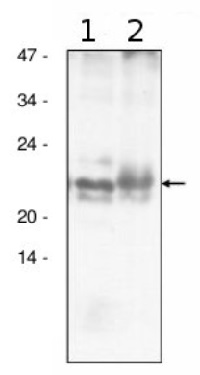1

Anti-AtpF | CF0I subunit of ATP synthase
This antibody is no longer available.
- Product Info
-
Immunogen: Isolated CF0I subunit of the chloroplast ATP synthase complex of Arabidopsis thaliana, UniProt UniProt::P56759, TAIR: ATCG00130
Host: Rabbit Clonality: Polyclonal Purity: Serum Format: Liquid Quantity: 100 µl Storage: Store at short-term 4°C, Long-term -20°. Repeated freezing and thawing is not recommended. It ontains 0,01% sodium azide. Tested applications: Blue Native PAGE (BN-PAGE), Western blot (WB) Recommended dilution: 1 : 5000 (BN-PAGE), (WB) Expected | apparent MW: 21 kDa
- Reactivity
-
Confirmed reactivity: Arabidopsis thaliana, Chlamydomonas reinhardtii, Spinacia oleracea, Ulva prolifera
Predicted reactivity: Cannabis sativa, Higher plants, Phaseolus vulgaris, Pisum sativum
Species of your interest not listed? Contact usNot reactive in: No confirmed exceptions from predicted reactivity are currently known - Application Examples
-
Application example 
20 µg of chloroplast fraction from Arabidopsis thaliana (1) and Spinacia oleracea (2) were separated on 12 % SDS-PAGE and blotted 1h to PVDF. Blots were blocked with 2 % non-fat milk powder in 1xTBS-T for 1h at room temperature (RT) with agitation. Blot was incubated in the primary antibody at a dilution of 1: 5 000 for 1h at RT with agitation. The antibody solution was decanted and the blot was rinsed briefly twice, then washed once for 15 min and 3 times for 5 min in TBS-T at RT with agitation. Blot was incubated in secondary antibody (anti-rabbit IgG horse radish peroxidase conjugated) diluted to 1:10 000 in for 1h at RT with agitation. The blot was washed as above and developed for 5 min with ECL according to the manufacturer's instructions. - Additional Information
-
Additional information: This product can be sold containing proClin if requested - Background
-
Background: The chloroplast ATP synthase belongs to the family of F1-type ATPases, which are also present in bacteria and mitochondria. ATP synthase generates ATP from ADP and inorganic phosphate using energy derived from a trans-thylakoidal electrochemical proton gradient. - Product Citations
-
Selected references: Lempiainen et al. (2022) Plants acclimate to Photosystem I photoinhibition by readjusting the photosynthetic machinery. Plant Cell Environ. 2022 Oct;45(10):2954-2971. doi: 10.1111/pce.14400. Epub 2022 Aug 16. PMID: 35916195.
Galvis et al. (2020). H+ transport by K+ EXCHANGE ANTIPORTER3 promotes photosynthesis and growth in chloroplast ATP synthase mutants. Plant Physiol. pp.01561.2019. doi: 10.1104/pp.19.01561.
Koochak et al. (2019). The structural and functional domains of plant thylakoid membranes. Plant J. 2019 Feb;97(3):412-429. doi: 10.1111/tpj.14127.
Lv et al. (2019). Uncoupled Expression of Nuclear and Plastid Photosynthesis-Associated Genes Contributes to Cell Death in a Lesion Mimic Mutant. Plant Cell. 2019 Jan;31(1):210-230. doi: 10.1105/tpc.18.00813.
Gao et al. (2018). A supercomplex, approximately 720 kDa and composed of both photosystem reaction centers, dissipates excess energy by PSI in green macroalgae under salt stress. Plant Cell Physiol. 2018 Oct 8. doi: 10.1093/pcp/pcy201.
Koochak et al. (2018). The structural and functional domains of plant thylakoid membranes. Plant J. 2018 Oct 12. doi: 10.1111/tpj.14127. (BN-PAGE)
Rantala and Tikkanen et al. (2018). Phosphorylation‐induced lateral rearrangements of thylakoid protein complexes upon light acclimation. Plant Direct Vol. 2, Issue 2.
Fristedt et al. (2015). The thylakoid membrane protein CGL160 supports CF1CF0 ATP synthase accumulation in Arabidopsis thaliana. PLoS One. 2015 Apr 2;10(4):e0121658. doi: 10.1371/journal.pone.0121658.
Grieco et al. (2015). Light-harvesting II antenna trimers connect energetically the entire photosynthetic machinery - including both photosystems II and I. Biochim Biophys Acta. 2015 Jun-Jul;1847(6-7):607-19. doi: 10.1016/j.bbabio.2015.03.004. Epub 2015 Apr 3.
Yap at al. (2015). AEF1/MPR25 is implicated in RNA editing of plastid atpF and mitochondrial nad5 and also promotes atpF splicing in Arabidopsis and rice. Plant J. 2015 Jan 13. doi: 10.1111/tpj.12756. - Protocols
-
Agrisera Western Blot protocol and video tutorials
Protocols to work with plant and algal protein extracts
Agrisera Educational Posters Collection
- Reviews:
-
This product doesn't have any reviews.



